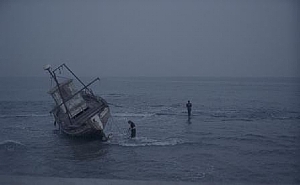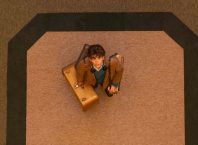Here is the description of the film ‘Andante’, according to the IMDB:
“In a post-industrial world people are no longer able to dream. A factory run by Mr Terrier sells the frightened, sleepless masses a dreaming experience. Sarah, the single surviving dreamer, sets out to the only place that can provide answers to her strange night-time visions: the dream factory. Her arrival excites Mr Terrier, who is searching for a new dreamer. The visions of the old comatose man, whose dreams Mr Terrier taps into, have become repetitive and dull. He must be replaced. Didi, Sarah’s lover, cuts and edits the dreams for Mr Terrier. To avoid Sarah turning out like the old man, Didi must save her. But for Terrier, Sarah holds the future of his company. He kidnaps her, tying her up then forcibly drugging her. After awakening, Sarah comes to realize the repercussions her dreams have had in the real world.”
That description may be absolutely correct, may accurately capture the filmmaker’s intentions and may be how the film will be remembered. I, however, did not see a film that corresponds with that description. There was no real narrative or conceptual structure that I could latch onto. I could not make heads or tails of what individual scenes were about, and generally had very little idea of how the previous scene related to the current one. What I saw was an utterly fascinating surreal audio-visual experience, at times transcendent and profound in ways that I could not put into words. At others, I was simply bewildered and perplexed. The only way I could make any kind of sense of this film, in fact, was to view it as a series of short films that were taking place in the same setting.
The film’s first scene is a transfixing exploration of lighting. A young man (David Fire) and a young woman (Sarah Adler) -who we later find out are called Didi and Sarah- are laying in an oversized bed the fills the screen. A considerable gust of wind and steady percussive sound (a heartbeat?) accompanies a dialogue they are having. To call it a dialogue may be inaccurate, though….in fact, it sounds like they are each sounding an internal monologue at each other (perhaps enforcing my sense of the film, where its elements are ostensibly connected but really stand alone). Their “dialogue” reminded me of Godard, as it is a series of almost impenetrable existentialisms -something that is true of the vast majority of the dialogue in the film (the sense of Godard is also enhanced by the image of a couple arguing in bed, recalling the opening of ‘Contempt’). As this couple internally monologue at each other and shift around positions on the huge bed, the lighting of the scene is constantly changing. As lighting changes, so does one’s sense of time, and of the space on the bed. It feels like days, or years, or eternities in these two people’s psyches go by in this (roughly) 10 minutes single shot, which ends with the bed being flooded by water (which can signify a couple of banal concrete thoughts, and a wide array of abstract ones). It is one of the most impressive scenes (or short films) I’ve seen so far at this festival, if not the most impressive.
There are a few more visually and aurally arresting scenes, and one must give a tremendous amount of credit to the visual team first-time director Assaf Tager assembled for this film- cinematographer Elad Debi, production designer Yoel Herzberg, and set-decorators Nir Alba, Noa Polanski, Na’ama Shendar. The spaces in this film leave a very strong impression, often more impressive that the dialogue or the character’s actions.
In the end, the most obvious way to tag this movie is to call it ‘dreamlike’, ‘surreal’, ‘Lynchian’. I would not give it that pass- I am not sure that this is really a film, and its almost purposeful insistence on being obscure and impenetrable at times seems like a ruse intended to give the film the appearance of a shape that’s not really there. Further viewings are needed for that. As it stands, however, Tager has created an arresting audio/visual specimen. It can be easily dismissed as pompous and artsy…but there are genuine wonders to be found in ‘Andante’







Comments are closed.